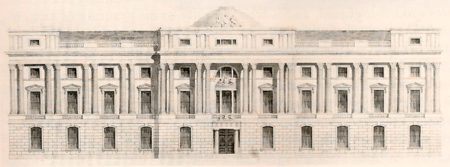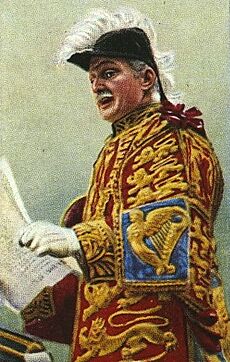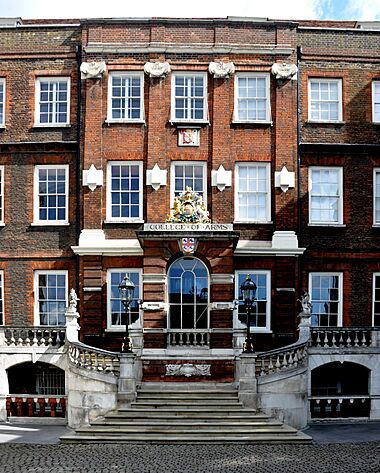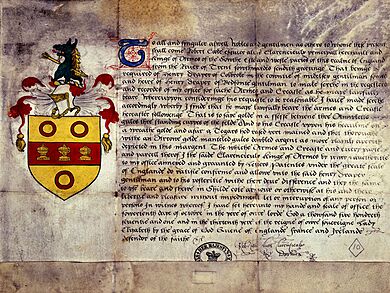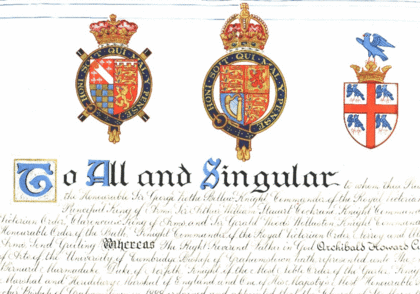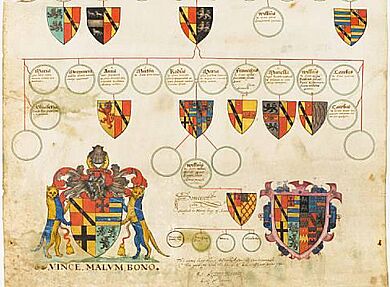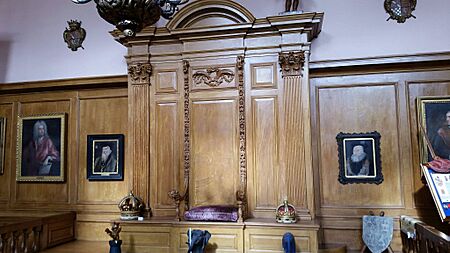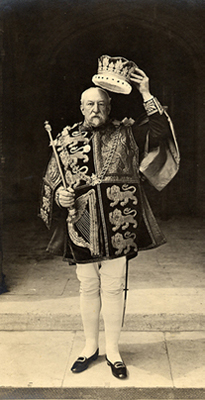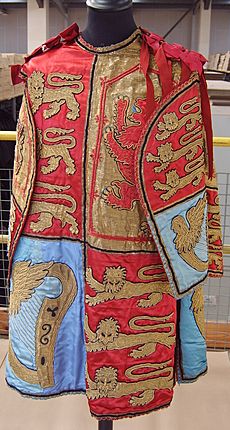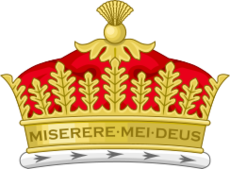College of Arms facts for kids
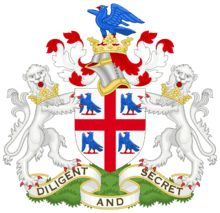 |
|
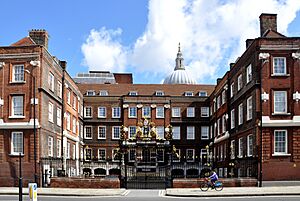
The College of Arms in London, with the dome of St Paul's Cathedral behind
|
|
| Royal Corporation | |
| Founded | 2 March 1484 (incorporated) 18 July 1555 (reincorporated) |
| Founder | Richard III of England Mary I of England & Philip II of Spain |
| Headquarters | 130 Queen Victoria Street City of London EC4V 4BT |
|
Area served
|
England, Wales, Northern Ireland, Australia and New Zealand |
|
Key people
|
Edward Fitzalan-Howard, 18th Duke of Norfolk, Hereditary Earl Marshal; David White, Garter Principal King of Arms |
| Services | Recording, granting and regulation of heraldry, coats of arms and pedigrees |
| Parent | Royal Household of the United Kingdom |
The College of Arms (also known as the Heralds' College) is a special group of experts called "officers of arms." They work for the British King or Queen and are in charge of things like coats of arms and family histories in England, Wales, Northern Ireland, and some other countries that are part of the Commonwealth. These officers, also known as heralds, are chosen by the British monarch. They have the power to create new coats of arms, help people research their family trees, and keep official records of family histories.
The College also handles rules for flying flags on land. They keep official lists of flags and other national symbols. Even though they are part of the Royal Household, the College pays for itself and does not use public money.
King Richard III of England started the College in 1484. It is one of the few official groups for heraldry left in Europe. In the United Kingdom, there are two such groups: the Court of the Lord Lyon in Scotland and the College of Arms for the rest of the UK. The College has been in the City of London since it began. It has been at its current spot on Queen Victoria Street since 1555. The College of Arms also helps plan many important events. These include coronations, state funerals, the yearly Garter Service, and the State Opening of Parliament. Heralds from the College often go with the King or Queen to these events.
The College has thirteen main officers or heralds. These are three Kings of Arms, six Heralds of Arms, and four Pursuivants of Arms. There are also seven "officers extraordinary" who join in ceremonies but are not part of the main College. The whole group is led by the Earl Marshal. This is a special job that has been passed down through the Duke of Norfolk family for a long time.
Contents
History of the College of Arms
How the College Began
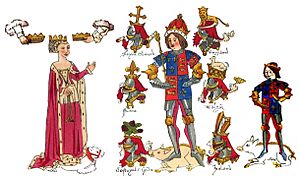
King Richard III of England was very interested in heraldry. He owned two important books of coats of arms. Before he became king, he was in charge of the heralds and wanted to improve their organization. After he became king, he made Sir John Howard the first Duke of Norfolk and Earl Marshal of England from the Howard family.
In 1484, King Richard III officially created the royal heralds as a group. He gave them a special document called a royal charter. This charter said that the heralds would always be a formal group. It also gave them a common seal of authority. The King also gave them a house called Coldharbour in London. This house was for storing their records and for the heralds to live in.
Ups and Downs Over Time
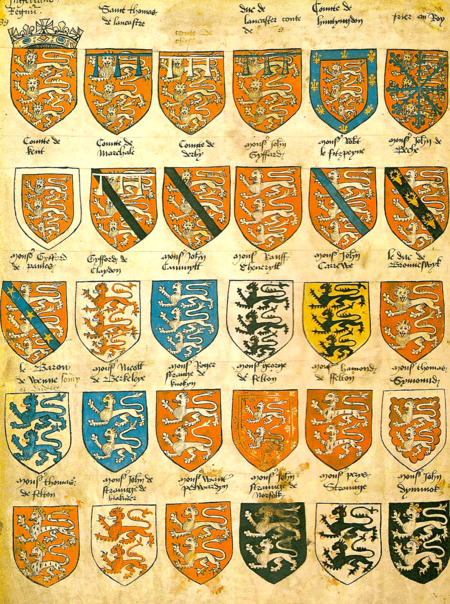
When King Richard III died in battle, the heralds lost their main supporter. The new king, Henry VII, took back the house that Richard III had given them. This left the heralds without a home, and many of their important books and records were lost. Even so, the heralds still had a place at the royal court. They had to attend the King at all times.
During the reign of King Henry VIII, the College became very important. Henry VIII loved grand events, which meant the heralds were very busy. They also traveled to other countries to deliver messages or declare war. In 1520, Henry VIII brought eighteen officers of arms to a meeting with the King of France.
However, the College still did not get its house back. They had to meet in different palaces or even in each other's homes. In 1530, Henry VIII gave the College a very important job: heraldic visitations. This meant the heralds could visit homes and churches to check if people were using coats of arms legally. They could even destroy coats of arms that were used wrongly. Many people were fined for breaking these rules. These visits continued for over a century.
Getting a New Start
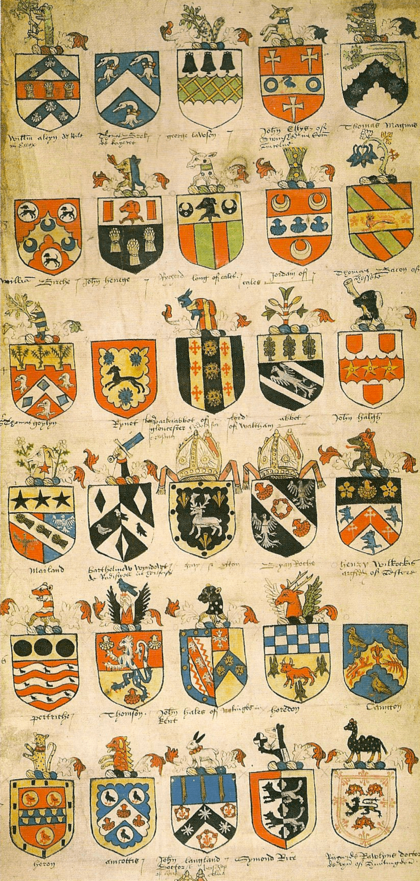
After some confusion about who should be queen, Mary I became queen. She and her husband, Philip II of Spain, gave the College a new house called Derby Place in 1555. This new charter also officially made the heralds a permanent group again. The house was meant to be a place for them to meet and keep their records safe. Derby Place was located near St Paul's Cathedral, where the College is today. Records show the building had about thirty-two rooms, used as offices and homes for the heralds.
Queen Elizabeth I confirmed the College's rights in 1566. During her long reign, there were many arguments among the heralds themselves. These fights often hurt the College's reputation. Reforms were made later to help solve these problems.
During the Civil War
When the English Civil War started in 1642, the College was divided. Some heralds supported King Charles I, while others sided with Parliament. The heralds asked Parliament to protect their important records. Those who supported the King were punished, losing their jobs and sometimes even being jailed. However, the College as an institution was protected by Parliament. Heralds continued their work, even attending Oliver Cromwell's ceremony as Lord Protector.
Surviving and Rebuilding
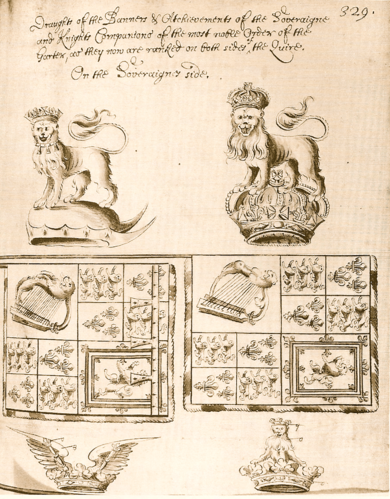
In 1660, the heralds announced King Charles II as the new King. All the changes made during the Civil War were canceled. Heralds who had supported the King got their jobs back. In 1666, the Great Fire of London completely destroyed Derby Place, the College's home. Luckily, the College's library was saved. It was moved to a temporary office.
Rebuilding the College was slow because of a lack of money. The heralds themselves contributed a lot of their own money. By 1683, the main part of the new building was finished. It was a three-story brick building with rooms for the heralds to live and work. The hall was later turned into the Court of Chivalry.
The coronation of James II in 1685 brought the College back into the spotlight. However, after his reign ended, the College's influence decreased for a while. The Acts of Union 1707 between England and Scotland did not change the College's role. The College of Arms and the Court of the Lord Lyon continued to work in their own areas.
Modern Times and Changes
In the 1700s, the College faced new challenges. A Sugar House built next to it was a fire risk, causing much worry. After many years, the College bought the Sugar House in 1820. This helped ease their financial problems. In 1820, King George IV gave the College money each year, which was the first time since 1555.
The College considered moving to a more fashionable location, even asking famous architect John Nash to design a new building near Trafalgar Square. However, these plans were too expensive and never happened. In 1842, they built a new octagonal Record Room on the old Sugar House site.
In 1861, a new road was planned that would have destroyed the College. Protests from the heralds saved most of the building, but parts of it had to be rebuilt. The College became a three-sided building facing the new Queen Victoria Street.
Looking to the Future
In 1869, an investigation looked into how the College was run. Some suggested that the College officers should be paid by the government, like other public servants. However, this idea was not put into action. The College remained an independent group.
Another inquiry in 1903 looked at the College's unique position. Heralds were royal officials but earned money from private fees. The inquiry decided that changing this was not practical at the time. In 1905, the yearly money from the Crown was stopped by the government.
A third inquiry in 1928 looked at criticisms of the heralds. It suggested that the College should work more closely with the Home Office. However, it agreed that the fee system for heralds was fine.
The College Today
In 1934, the College celebrated its 450th anniversary with an exhibition. Many people visited, including the Duke and Duchess of York (who later became King George VI and Queen Elizabeth The Queen Mother).
During World War II, the College's records were moved to a safe place. In 1941, the College building itself was almost destroyed by fire, but a change in the wind saved it. All records were returned safely after the war.
In 1943, the College took on new duties when the office of Ulster King of Arms was combined with Norroy King of Arms. This created the new office of Norroy and Ulster King of Arms.
The College building needed major repairs after the war. With help from the government and public donations, it was fixed. New gates were added in 1956. In 1984, the College celebrated its 500th anniversary with a special service. Queen Elizabeth II attended this event.
In 2009, a fire broke out in the west wing of the College building. Luckily, no records or books were damaged. Repairs were completed later that year.
What the College of Arms Does
Ceremonial Duties
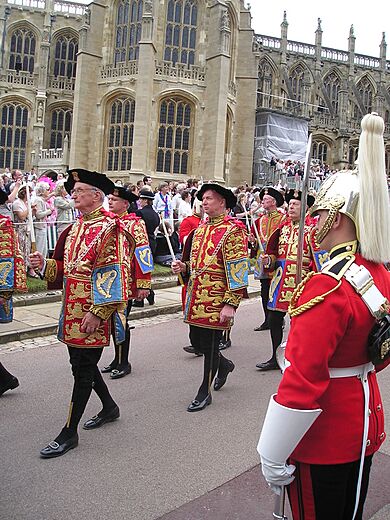
The College of Arms is part of the Royal Household. This means its officers go with the King or Queen to important state events. These events show the majesty and power of the monarch. Today, heralds wear their full uniforms only twice a year: at the State Opening of Parliament and at the Garter Service. The Earl Marshal is in charge of planning all state ceremonies, so the heralds have a role in every major royal event.
At the State Opening of Parliament, the heralds lead the Royal Procession before the King or Queen. They walk from the Victoria Tower to the House of Lords. After the King or Queen puts on the Imperial State Crown, the heralds lead them into the House of Lords. They stay with the monarch during the speech and then accompany them back.
The Garter Service is held every June at St George's Chapel, Windsor Castle. New members of the Order of the Garter receive their special badges from the King or Queen. Afterwards, everyone has lunch wearing their blue velvet robes. Then, they walk in a procession to St George's Chapel. Members of the College of Arms lead this procession in their special tabards.
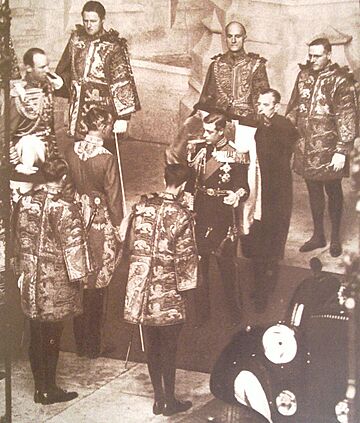
Heralds also play a key role when a monarch dies. After the death of a King or Queen, the Accession Council meets to announce the new monarch. Heralds are given the job of reading this announcement in different places in London. The first reading is usually from the balcony at St. James's Palace. Another reading happens at Temple Bar, where heralds formally ask to enter the City of London.
During a Coronation Ceremony, College members are part of the Royal procession into Westminster Abbey. The Garter King of Arms helps guide the ceremony. Only the Kings of Arms are allowed to wear their special crowns during this ceremony, besides the King and Queen.
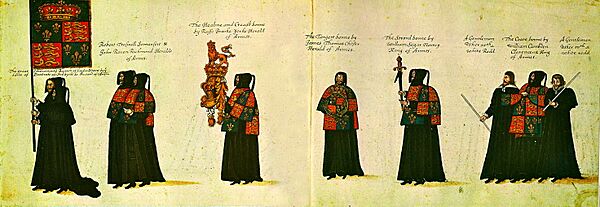
At State funerals, heralds again lead the royal procession. In the past, during royal funerals, heralds would carry pieces of armor. This showed the importance of chivalry. One of the most serious jobs for heralds at a royal funeral is to read out all the titles of the dead monarch. For example, in 2002, the Garter King of Arms read all the titles of Queen Elizabeth The Queen Mother at her funeral.
Granting and Proving Coats of Arms
Only the British monarch can grant armorial bearings (coats of arms) in the UK. However, the monarch has given this power to two groups: the Lord Lyon for Scotland, and the College of Arms for England, Wales, and Northern Ireland. Under the College of Arms, you can get a coat of arms in two main ways. You can prove you are a direct male descendant of someone who already has one. Or, you can get a new one granted by the King of Arms.
When someone wants a new coat of arms, they apply through a special document called Letters Patent. The King of Arms has the power to grant these, but first, the Earl Marshal must agree. This system has been in place since 1673. First, a person submits a request to the Earl Marshal. An officer of arms helps them prepare this request. There are no strict rules for who can get a coat of arms today. However, the College looks at things like awards, military service, university degrees, and public service.
How to Get a Coat of Arms Today
The fee for a coat of arms is paid when the request is submitted. As of January 1, 2024, a personal grant of arms costs £8,950. A grant for a non-profit group costs £18,415, and for a business, it's £27,450. These fees cover the cost of creating the artwork and writing on the special document, which is done by hand. They also cover other costs for the heralds and the College's upkeep.
Once the Earl Marshal approves, the King of Arms starts designing the coat of arms. The King of Arms has the final say on the design, but they consider the applicant's wishes. The design must follow all heraldry rules and be completely new. A sketch is sent to the applicant for approval.
When the design is agreed upon, the final grant is made. This is a beautiful, handmade document written and painted on vellum by a College artist. The King of Arms signs and seals it, and then it is given to the applicant. A copy is always kept in the College's records.
Once granted, a coat of arms belongs to the owner and their male descendants. To prove you have the right to use a coat of arms by family descent, you must show that an ancestor's arms are recorded at the College. An officer at the College can help you research your family history to find this proof.
Changing Names and Arms
The College of Arms is also a place where you can officially record a change of name. While you don't need a special document to change your name in common law, you can use a deed poll. This document shows your intention to use a new name. These deeds can be recorded at the College and are usually published in the London Gazette.
You can also change your coat of arms, sometimes with a new surname, through a Royal Licence. This is a special permission from the King or Queen. It is usually given if there's a good reason, like a requirement in a will. The Royal Licence is only official once it's recorded at the College.
Family History Records
Because coats of arms are passed down through families, the College has been involved in genealogy (family history) since the 1400s. They do research for people with families in the British Isles. The College has a huge collection of family history materials, like family trees, going back over five centuries.
If you want your family's history recorded at the College, an officer can help you. They make sure the family tree is in the correct format and advise you on what documents you need to prove your family connections. After it's checked by other officers, the family tree is officially recorded in the College's register.
The Roll of the Peerage
The House of Lords Act 1999 changed how hereditary peers (people with inherited titles) sit in the House of Lords. Before this, anyone inheriting a title would prove it by getting a special summons to Parliament. This was recorded in the Register of Lords Spiritual and Temporal. After the Act, this register only includes life peers and the 92 hereditary peers who still sit in the House of Lords.
To keep a full record of all peers, Queen Elizabeth II issued a Royal Warrant in 2004. This created a new record called the Roll of the Peerage. The Crown Office now maintains this roll in consultation with the Garter King of Arms and the Lord Lyon King of Arms. The College of Arms publishes the roll, and an online version is available.
Work Outside the UK
The College of Arms says it is the official heraldic authority for England, Wales, Northern Ireland, and much of the Commonwealth, including Australia and New Zealand. The job of New Zealand Herald Extraordinary was created in 1978. This officer works with the College to grant new arms in New Zealand.
However, the Australian government has not fully confirmed the College's official status there. They say that grants from the College of Arms are one way Australians can get heraldic symbols, but they have the same status as those from a local artist. Some groups in Australia believe the government should create its own national heraldic body, like the Canadian Heraldic Authority.
The Earl Marshal
The Earl Marshal is one of the most important officers of the state. This job has existed since 1386. Since 1672, the job has been passed down through the family of the Duke of Norfolk. The current Earl Marshal is Edward Fitzalan-Howard, 18th Duke of Norfolk.
The Earl Marshal's job started with military duties. Over time, it changed to focus on state and royal ceremonies. By the 1500s, this included overseeing the College of Arms and its heralds. So, the Earl Marshal is the head of the College of Arms. All important decisions, like appointing new heralds, need his approval. The Earl Marshal also controls the flying of flags in England and Wales. The College of Arms keeps the official lists of flags and advises the government on flag rules.
| Head of the College of Arms | |||
|---|---|---|---|
| Arms | Titles and offices | Name (date of succession) |
Notes |
 |
Duke of Norfolk, Earl Marshal and Hereditary Marshal of England |
Edward William Fitzalan-Howard, 18th Duke of Norfolk, GCVO, DL (24 June 2002) |
Edward, Duke of Norfolk (born 1956) became Earl Marshal when his father died in 2002. His oldest son, Henry Fitzalan-Howard, Earl of Arundel (born 1987), is next in line for the job. |
The Court of Chivalry
The High Court of Chivalry is a special court in England led by the Earl Marshal. It handles all matters related to heraldry. It makes sure the College of Arms' decisions are legal and followed. The court deals with cases about social rank and disputes over using someone else's coat of arms. The Court of Chivalry meets at the College of Arms. The last time it met was in 1954, after 230 years.
Heralds of the College
The College of Arms is made up of thirteen main heralds, called Officers in Ordinary. They are ranked into three groups: three Kings of Arms, six Heralds of Arms, and four Pursuivants of Arms. There are also seven Officers Extraordinary who join in ceremonies but are not part of the main College. Heralds are chosen by the King or Queen based on the Earl Marshal's recommendation.
All the main officers of the College have old titles. Some started as private servants of noblemen, while others were royal from the beginning. Their names and badges come from the titles and royal badges of England's monarchs. The Officers Extraordinary get their names from the titles of the Earl Marshal.
How Heralds are Paid
The College pays for almost everything itself and does not get regular public money. Its officers do have official salaries paid by the Crown, but these amounts are very small today. For many centuries, heralds have also earned money by doing private work in heraldry and genealogy. The government pays the Garter King of Arms for work done for the government. As of early 2021, Sir Thomas Woodcock had received over £650,000 since becoming Garter. He also gets money for expenses like secretarial help.
| Officers in Ordinary | 1618 Salary | 1831 Salary | Present Salary (approx.) |
|---|---|---|---|
| Garter King of Arms | £100 | £49 1s. 4d | £49.07 |
| Provincial Kings of Arms | £40 | £20 5s. | £20.25 |
| Heralds | £26 13s. 4d | £17 16s. | £17.80 |
| Pursuivants | £20 | £13 19s. | £13.95 |
Note: The right-hand column is simply the decimal equivalent of the 1831 column.
What Heralds Wear
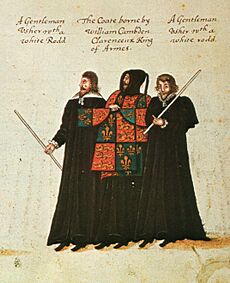
The most famous part of a herald's uniform is their tabard. This special coat has been worn since the 1200s. It shows that the herald represents their master, especially if their master is the King or Queen. Today, the herald's tabard is a historical garment, like a judge's wig.
The tabards for different officers are made of different fabrics. A King of Arms's tabard is made of velvet and cloth of gold. A Herald's tabard is satin, and a Pursuivant's is damask silk. All tabards have the Sovereign's royal arms richly embroidered on them. In the past, pursuivants wore their tabards with the sleeves at the front and back, but this stopped in the reign of James II. Until 1888, the Crown provided all tabards. Now, heralds usually pay for their own or buy one from their predecessor. The Lord Chamberlain now keeps a stock of tabards that can be loaned. Heralds and pursuivants also wear black velvet caps with a special badge.
Besides tabards, heralds wear scarlet court uniforms with gold embroidery for formal events. They wear white breeches and stockings for coronations and black for other times. They also wear black shiny court shoes with gold buckles. Scottish heralds wear black trousers with gold lace. Heralds also have special sceptres, which are symbols of their job. These are short black or white sticks with gilded ends and a special badge. They also wear a Collar of SS over their uniforms. For bad weather, they wear a large black cape. At state funerals, they wear a wide black silk sash over their tabards.
The three Kings of Arms have been allowed to wear a crown since the 1200s. Their silver-gilt crowns have sixteen leaves and a Latin phrase from Psalm 51. Inside the crown is a crimson velvet cap lined with ermine. In olden times, Kings of Arms had to wear their crowns on four special feast days. Today, the crown is only worn for the most important events, like the coronation of King Charles III and Queen Camilla in 2023. At other times, Kings of Arms wear a black bicorne hat with white ostrich feathers or a black velvet cap.
The New Zealand Herald of Arms Extraordinary is a special case. They wear the tabard only when in the UK for duties. In New Zealand, they wear morning dress as their official uniform, along with their chains and baton.
What it Takes to be a Herald
There are no formal qualifications to be a herald, but you need special knowledge and skills. Most current officers are trained lawyers and historians. In 1586, writer John Ferne said a herald should be a "Gentlemen and an Old man" who knows many subjects and understands war. Some of the greatest scholars and historians were members of the College.
However, some controversial appointments have been made. For example, in 1704, architect Sir John Vanbrugh became Clarenceux King of Arms, even though he knew little about heraldry. He was still considered a very distinguished person.
List of Heralds
Officers in Ordinary
| Kings of Arms | |||
|---|---|---|---|
| Arms | Office | Name (date of appointment) |
Notes |
 |
|
(1 July 2021) |
The most senior King of Arms. His title comes from the Order of the Garter. This office started in 1415. |
 |
|
(28 October 2024) |
His area is the part of England south of the River Trent. Clarenceux is the senior of the provincial Kings of Arms. This office started around 1334. Its name comes from the royal Dukedom of Clarence. |
 |
|
(14 November 2024) |
His area is the part of England north of the River Trent (Norroy) and Northern Ireland (Ulster). This office was created in 1943 when the Norroy and Ulster King of Arms offices were combined. Norroy started around 1276, making it very old. Ulster started in 1552. "Norroy" means "north king" in French. |
| Heralds of Arms in Ordinary | |||
| Badge | Office | Name (date of appointment) |
Notes |
 |
|
(31 May 2012) |
The first York Herald likely served the Duke of York around 1385. It became a royal herald in 1484. |
 |
|
(5 July 2019) |
This office might have started for the Order of the Garter in 1348, or even earlier. |
 |
|
(2 November 2023) |
Originally served the Dukes of Lancaster. First appeared in 1347. |
 |
|
(12 April 2024) |
Known to have served the Duke of Somerset in 1448. |
 |
|
(2 December 2024) |
Said to have been created by King Edward III for Edward, the Black Prince. |
 |
|
Since 2024 |
From 1421 to 1485, Richmond was a herald to various dukes and earls who held the Richmond estate. |
| Pursuivants of Arms in Ordinary | |||
| Badge | Office | Name (date of appointment) |
Notes |
 |
|
(20 February 2023) |
Named after St George's Cross, a symbol of England. Started around 1418. |
 |
|
(6 November 2023) |
Started by Henry VII in 1485. Named after the red dragon of Wales. |
 |
|
(16 April 2024) |
Likely started by Henry V for the Order of the Garter. |
 |
|
Since 2024 |
Started by Henry VII around 1490, named after his mother's badge. |
Officers Extraordinary
| Officers of Arms Extraordinary | |||
|---|---|---|---|
| Badge | Office | Name (date of appointment) |
Notes |
 |
|
(6 February 1978) |
Created in 1978. This officer oversees heraldry in New Zealand and works with the College. The badge is a crowned Maori koru. |
 |
|
(25 January 1989) |
Revived in 1887. Originally started around 1540. |
 |
|
(25 October 1994) |
This officer served the Dukes of Norfolk starting in 1539. |
 |
|
(2 August 2010) |
This office existed briefly in the late 1300s and was re-established in 1963. |
 |
|
(3 May 2022) |
Originally a private herald in the Earl of Arundel's household around 1413. Revived in 1727. |
 |
|
(7 October 1998) |
First appointed for Queen Victoria's coronation in 1837. |
The College's Coat of Arms
 |
|
More About the College
- St Benet Paul's Wharf – This is the official church of the College.
- White Lion Society – A group started in 1986 to help the College of Arms with donations and publications.
- The Heraldry Society – An organization dedicated to studying heraldry.
Similar Groups Around the World
- Court of the Lord Lyon – In Scotland, United Kingdom.
- Canadian Heraldic Authority – In Canada.
- Genealogical Office – In the Republic of Ireland.
- Bureau of Heraldry – In South Africa.
Topics the College Handles
- English heraldry
- Welsh heraldry
- Northern Irish Heraldry
- Australian heraldry
- New Zealand heraldry
See also
 In Spanish: College of Arms para niños
In Spanish: College of Arms para niños


